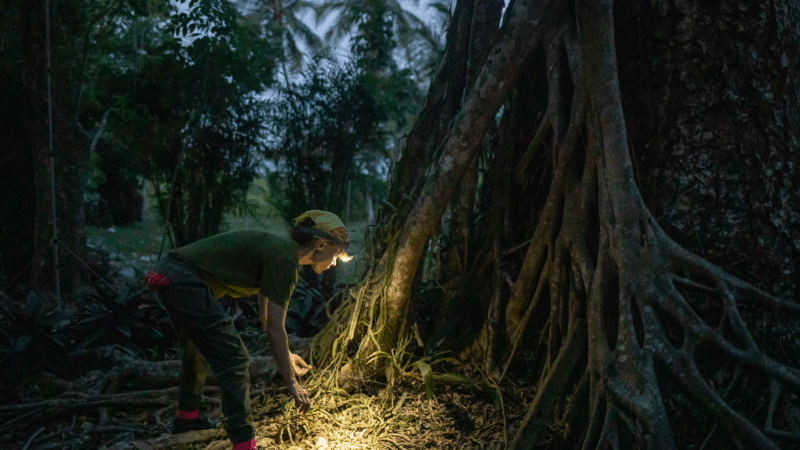Scientists want to track the world’s biodiversity using DNA in the air
Outside her cabin in northern Belize, Elizabeth Clare, a biodiversity scientist at York University, walks along a path. Everywhere she looks, it’s teeming with life.
“There’s hibiscus flowers over there,” she says. “One of my favorite things to find in this part of the world is leaf-cutter ants.” She points out the kingfisher birds that can be spotted flying overhead and the iguanas populating the trees.
“You can look at a couple square feet of ground here and never possibly describe all the things that are in it,” Clare says. “This is the problem of biodiversity. How do you describe this? I mean, I don’t know. No one knows.”
It’s a question that’s become ever more urgent to answer given how many species around the world are in danger of winking out due to habitat loss, climate change, and other disruptions.
“We don’t know what lives on planet Earth,” says Clare. “Most things in the world have never been recognized by science. So we wanted to see whether we could measure biodiversity on the scale of an entire country — actually monitor it over and over again to tell us how things are changing.”
In a preprint article published on bioRxiv that hasn’t yet been peer reviewed, she and her colleagues say they’ve done just that — by pulling DNA out of the air.
The parts of ourselves we can’t help but leave behind
To help explain the approach, Nina Garrett, a biology PhD student at York University, approaches a colossal guanacaste tree erupting out of the ground not too far from that path Clare was pacing. A good half of it is in the grip of a strangler fig tree. But at the base of the trunk is a hole that Garrett can just peek inside.
“Now you can hear them chittering,” says Garrett, referring to a group of common vampire bats that she knows reside in this tree. In fact, she spots a baby on the inner back wall of the trunk. “It’s not uncommon to see a pup without a mom inside the roost,” she says.
But Garrett is curious if there might also be white-winged vampire bats inside — a different species. “It’s never been caught here physically,” she says, “but it’s always been suspected to be in the area just based on habitat type and range maps.”
The problem is that bats are elusive and skittish. Most techniques would likely spook any animals roosting here. So how can Garrett tell what’s inside this tree?
It turns out that even if the bats themselves are out of reach, they can’t conceal themselves completely. That’s because they cast small fragments of their DNA into the environment. Clare says all creatures big and small are forever “losing little bits of themselves. It’s what we do by being alive.” She says to think of it like a footprint that all of life leaves behind.
“They are shedding hair, could be little skin cells, it could be saliva,” says Garrett. “Anything that they are putting out into the environment — even when they breathe out.”
Garrett wants to collect this environmental DNA, or eDNA, from inside the tree to deduce who’s here. She lays a piece of filter paper atop a small fan, places the apparatus inside the tree, and flips the switch.
The fan draws the internal air across the filter, trapping free-floating DNA, which Garrett can analyze later for the presence of not just white-winged vampire bats, but any mammal. If she wanted, she could survey the genetic material for different species of plants and fungi too. This is the power of the technique: It can catalog the breadth of life crammed into a place like this little tree hollow.

(Luis Echeverría for NPR)
The problem is that a single tree doesn’t tell you how species are doing on a grander scale. And most techniques that operate over broader areas don’t allow you to focus on many kinds of organisms at once.
Clare wanted to think bigger, at the level of a nationwide census of all living things. It’s something that she says is needed urgently given the number of species threatened with extinction — “to be able to monitor whether conservation plans have any effect” and whether remediation efforts after some large environmental disruption are actually working.
But Clare didn’t know how she’d even attempt such a thing. “How to measure everything everywhere all at once — there’s no way of doing that in our toolbox of tools at the moment.”
Snatching DNA out of the air across an entire country
Then, a few years ago, a group of British chemists and physicists from the National Physical Laboratory (NPL) got in touch with Clare. This group monitors pollution levels across the U.K. using a network of stations that continuously draw air from the environment across little discs of filter paper to capture, among other pollutants, heavy metals. In other words, the basic setup mirrors the one in that guanacaste tree.
“We soon realised that the large number of filters we analyze for the air quality networks might contain some hidden information about species abundance,” says Andrew Brown, an air quality scientist with the NPL. “So we got in touch with Beth.”
Clare and her colleagues took about a year’s worth of these filters from across the U.K. When they analyzed them for DNA, they were astonished by what they found: hundreds upon hundreds of different insects and spiders, a heap of plants and fungi, and more than a hundred species of birds and mammals.
“It’s like a treasure hunt for biodiversity scientists,” she says. “Those same systems, it turns out, have been accidentally capturing this airborne DNA that we want.”
The approach may not be as detailed as a fleet of human observers, but sometimes it identifies organisms that people would miss.
“Compared to large-scale citizen science programs with thousands to tens of thousands observations,” writes Orianne Tournayre, a molecular ecologist at York University and lead author on the manuscript, “airborne eDNA recovered fewer taxa overall, but detected species that are harder to spot or identify visually.”
Each filter disc on its own stored just a morsel of information, “but when you have hundreds of them being collected all the time, over and over again, at spatially distributed scales,” says Clare, “and you step back, all of those dots coalesce into a picture.”
It is a picture of the biodiversity of a nation — and how that picture changes as species invade a new area or disappear altogether. “These advances could also be used to identify pathogens and agricultural pests,” adds Brown.
“If filter storage is optimized for DNA preservation, this could pave the way for a highly standardized, scalable, and cost-effective monitoring system that operates almost continuously,” writes Tournayre. “It would be like turning our air quality network into a global wildlife monitoring system: the same network designed to protect human health could become a system for protecting wildlife as well.”
Ryan Kelly is a marine scientist at the University of Washington who studies environmental DNA and wasn’t involved in the research.
“What I think is really cool here,” he says, “is we can see the whole living world based on the DNA in the air, and we can do it all without any new infrastructure.”
Kelly says it’s not yet clear over what area or timeframe these pollution monitoring stations are sampling the DNA. He remains enthusiastic, however, about what the approach can facilitate. “If we have biodiversity management questions, all sorts of environmental impact questions, things that we’ve never really known how to do at scale before,” he says, “I think this paper points the way to doing that.”
Clare argues this may be just the beginning of bigger things to come.
“If we can do it at the level of a country,” she says, “we can do it at a level of a continent, we can do it at multiple continents. This is something that truly could scale to huge, almost planetary measurements.”
Transcript:
SCOTT DETROW, HOST:
We know that Earth’s biodiversity is in crisis, but it’s hard to monitor lots of different species at once to know exactly how they are changing. Well, NPR’s reporter Ari Daniel met a team of researchers who say they have a technique to do just that across an entire country.
(SOUNDBITE OF BIRDS CHIRPING)
ARI DANIEL, BYLINE: We’ll start at the base of a colossal guanacaste tree erupting out of the ground in northern Belize. At the base of the trunk is a hole I can just peek inside.
(SOUNDBITE OF FOOTSTEPS)
NINA GARRETT: Now you can hear them chittering.
DANIEL: I follow Nina Garrett’s gaze into that hole.
(SOUNDBITE OF BAT CHITTERING)
DANIEL: Oh, yeah, a little guy.
GARRETT: Yeah.
DANIEL: He’s on, like, the back wall of the trunk.
GARRETT: Yeah.
DANIEL: It’s a common vampire bat. Now, Garrett, who’s a biology grad student at York University in Canada, knows that a whole group of these bats reside in this tree. But she’s curious if there might also be white-winged vampire bats inside – a different species.
GARRETT: It’s always sort of been suspected to be in the area just based on habitat type and range maps.
DANIEL: But bats are elusive and skittish. Most techniques would likely spook any animals roosting here. So how can Garrett tell what’s inside this tree? Well, the bats can’t hide completely. All creatures, big and small, are forever losing pieces of themselves, little fragments of DNA cast into the environment.
GARRETT: They are shedding hair. It could be little skin cells. It could be saliva, even, when they, you know, breathe out.
DANIEL: Garrett wants to collect this environmental DNA from inside the tree to deduce who’s here.
(SOUNDBITE OF FILTER PAPER CRINKLING)
DANIEL: She lays a piece of filter paper atop a small fan, places the apparatus inside the tree, and flips the switch.
(SOUNDBITE OF FAN RUNNING)
DANIEL: The fan draws the internal air across the filter, trapping free-floating DNA, which Garrett can analyze later for the presence of not just bats but any mammal and, if she wanted, plants and fungi too. That’s the power of this technique. It can catalog the array of living things in and around this trunk. Problem is, a single tree hollow doesn’t tell you how species are doing on a grander scale. And Elizabeth Clare, a biodiversity scientist at York University, wanted to think bigger.
ELIZABETH CLARE: We wanted to see whether we could measure biodiversity on the scale of an entire country.
DANIEL: But she didn’t know how to even attempt such a thing. Then, a few years ago, a team of British chemists and physicists reached out with an idea. This group monitors pollution levels across the U.K. using a network of stations that continuously draw air from the environment across little disks of filter paper, a lot like the setup in that guanacaste tree.
CLARE: Those same systems, it turns out, have been accidentally capturing this airborne DNA that we want, at the same time.
DANIEL: Clare and her colleagues took about a year’s worth of these filters and analyzed them for DNA. They were astonished by what they found – hundreds of different kinds of insects and spiders, a heap of plants and fungi, and more than a hundred species of birds and mammals. Each filter disc on its own stored just a morsel of information.
CLARE: But when you have hundreds of them being collected all the time at spatially distributed scales and you step back, all of those dots coalesce into a picture.
DANIEL: A picture of the biodiversity of a nation and how that picture is changing. The results appear in a preprint article that hasn’t yet been peer reviewed. Ryan Kelly studies environmental DNA at the University of Washington and wasn’t involved in the research. He says that unlike a traditional census, DNA is a fuzzier representation of how various organisms are living at a specific place and time. But he finds the approach compelling, given the possibilities it might open up.
RYAN KELLY: If we have biodiversity management questions, all sorts of environmental impact questions, things that we’ve never really known how to do at scale before, I think this paper points the way to doing that.
DANIEL: And this may be the beginning of bigger things to come, given that these kinds of stations that monitor pollution are distributed in many places around the world, says Elizabeth Clare.
CLARE: If we can do it at the level of a country, we can do it at the level of a continent. This is something that truly could scale to huge, almost planetary measurements.
DANIEL: Imagine that – an ongoing census of global biodiversity pulled right out of thin air. For NPR News, I’m Ari Daniel.
Former U.S. Sen. Doug Jones announces run for Alabama governor
Jones announced his campaign Monday afternoon, hours after filing campaign paperwork with the Secretary of State's Office. His gubernatorial bid could set up a rematch with U.S. Sen. Tommy Tuberville, the Republican who defeated Jones in 2020 and is now running for governor.
Scorching Saturdays: The rising heat threat inside football stadiums
Excessive heat and more frequent medical incidents in Southern college football stadiums could be a warning sign for universities across the country.
The Gulf States Newsroom is hiring an Audio Editor
The Gulf States Newsroom is hiring an Audio Editor to join our award-winning team covering important regional stories across Mississippi, Alabama and Louisiana.
Judge orders new Alabama Senate map after ruling found racial gerrymandering
U.S. District Judge Anna Manasco, appointed by President Donald Trump during his first term, issued the ruling Monday putting a new court-selected map in place for the 2026 and 2030 elections.
Construction on Meta’s largest data center brings 600% crash spike, chaos to rural Louisiana
An investigation from the Gulf States Newsroom found that trucks contracted to work at the Meta facility are causing delays and dangerous roads in Holly Ridge.
Bessemer City Council approves rezoning for a massive data center, dividing a community
After the Bessemer City Council voted 5-2 to rezone nearly 700 acres of agricultural land for the “hyperscale” server farm, a dissenting council member said city officials who signed non-disclosure agreements weren’t being transparent with citizens.









